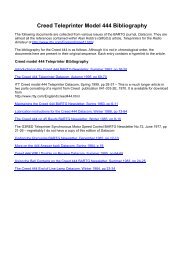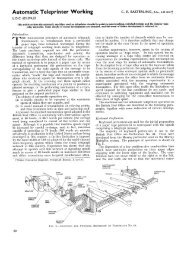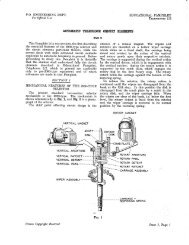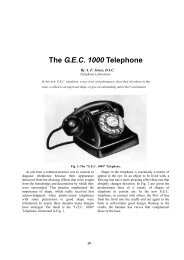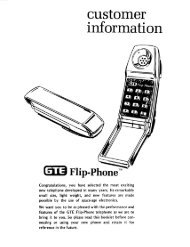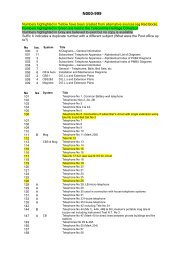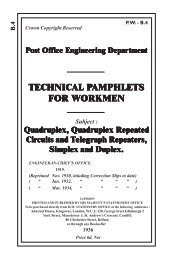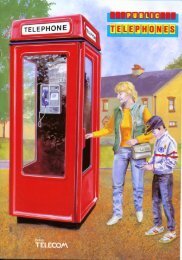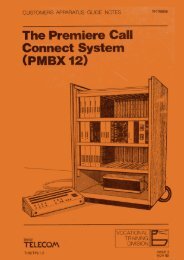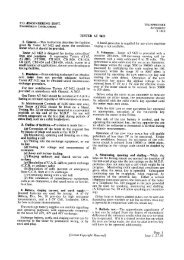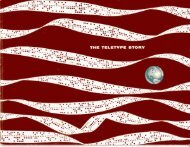TRAFFIC CONTROL TELEPHONE SYSTEMS Circuit - Sam Hallas
TRAFFIC CONTROL TELEPHONE SYSTEMS Circuit - Sam Hallas
TRAFFIC CONTROL TELEPHONE SYSTEMS Circuit - Sam Hallas
Create successful ePaper yourself
Turn your PDF publications into a flip-book with our unique Google optimized e-Paper software.
Case), K2 terminal (Time Sending Set), time key contacts, R relay contacts, K3<br />
terminal, time key contacts, K1 terminal (Time Sending Set), K1 terminal (Apparatus<br />
Case), B4 terminal (Apparatus Case) and 10 volts positive. When SR operates an<br />
impulse is sent to line which steps all selectors momentarily to the time ringing<br />
position, thus giving the first "pip" of a pre-arranged time signal.<br />
The relay R remains operated when the time sending contacts are opened via 10<br />
volts negative, B3 terminal (Apparatus Case), B3 terminal (Time Sending Set), make<br />
before break contacts of R, coil of R, 100 ohms, K3 terminal, time key contacts, K1<br />
terminal (Time Set and Apparatus Case), B4 terminal (Apparatus Case) and 10 volts<br />
positive.<br />
Relay R holds SR operated so that on the opening of the time signalling contacts<br />
no impulse is transmitted. The opening of the time signalling contacts removes the<br />
short circuit across the AN relay coil and allows it to operate. On the second closure<br />
of the time sending contacts, negative 10 volts is applied to both sides of R relay, thus<br />
shorting it, and it becomes de-energised. The dropping off of R releases SR and the<br />
second impulse of the time signal is transmitted. The opening of the time sending<br />
contacts releases relay AN thus one cycle of operations of the time sending relay<br />
circuit corresponds to two impulses from the time sending contacts.<br />
Relay AN is made slow releasing so that when the time sending impulses are<br />
obtained from a telegraph circuit, telegraph code impulses which may be in transmission<br />
may be in transmission after the key has been thrown to “Time” will be ineffective.<br />
At the end of the time sending transmission, the key is restored to the “Call”<br />
position, a code is sent out to the line (this can be originated by any selector key in the<br />
key case), the selectors are restored to normal and the system is then ready for<br />
ordinary calls.<br />
SUPERIMPOSED CIRCUITS<br />
Since the impulses for operating selectors are transmitted as alternating current<br />
at a definite frequency, suitable repeating coils or transformers may be connected in<br />
the line. The requirements for such coils are that they shall introduce low loss at both<br />
the signalling frequency and at speech frequencies.<br />
Page 11



